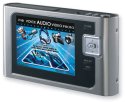PMP gains Linux-based firmware upgrade
Dec 5, 2005 — by LinuxDevices Staff — from the LinuxDevices Archive — views PocketNow.com has previewed a Linux-based portable media player (PMP) expected to reach market early next year. The Neuros Audio 442 PMP currently ships with a proprietary RTOS, but will be switched early next year to a Linux firmware release described in the… PocketNow.com article.
PocketNow.com has previewed a Linux-based portable media player (PMP) expected to reach market early next year. The Neuros Audio 442 PMP currently ships with a proprietary RTOS, but will be switched early next year to a Linux firmware release described in the… PocketNow.com article.
Neuros will offer discounts and low-cost upgrades to existing customers when the Linux-based version ships, it says. It is unclear whether Neuros's $99 “hardware upgrade” program includes new hardware, such as a memory upgrade, or merely a firmware upgrade.
Neuros has also launched an interesting open source hardware project behind the 442 — it has published detailed technical specifics for the next planned hardware revision, in hopes of attracting open source input early, and ensuring interest and participation from the Linux hacker community.
The 442 is a small, stainless steel-encased device about the size of a one-inch thick index card (3 x 5.3 x 1 inches). It is based on a dual-core RISC/DSP chip from Texas Instruments, and features a 3.6-inch QVGA (320 x 240 pixel) display and 40GB harddrive.
The 442 can be used to store, play, and record a variety of multimedia files, including photos, music, and videos. It connects to PCs as a USB 2.0 mass storage device. It has a fixed battery claimed to offer nine hours of music, or five hours of video playback.
PocketNow reviewer Adam Lein says the 442 is great for watching digital video content on-the-go. It is less useful as a music player, he says, and it suffers from several interface problems that Neuros and/or the open source community working on the firmware port will have to fix.
For example, the built-in filemanager's delete and copy functions do not work, Lein says.
Additionally, Lein identifies a variety of places where lack of polish could be refined by the open source community over time. For example, he expresses frustration that the device's music player relies on filesystem structure, rather than id3v2 tags, to organize music.
Still, the 442 is useful and fun, Lein says. Video playback is very smooth, and the device can be used to digitize music or videos from a variety of sources, including analog sources such as VHS tapes and records.
Additional details can be found in the full review, here.
This article was originally published on LinuxDevices.com and has been donated to the open source community by QuinStreet Inc. Please visit LinuxToday.com for up-to-date news and articles about Linux and open source.